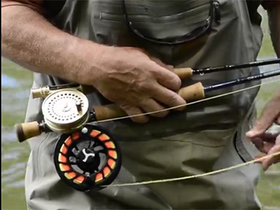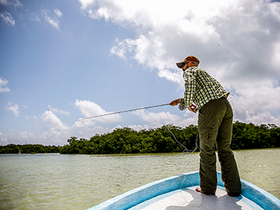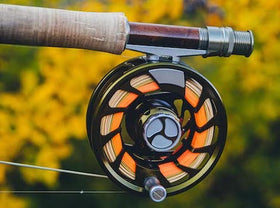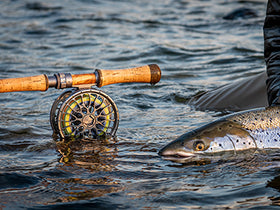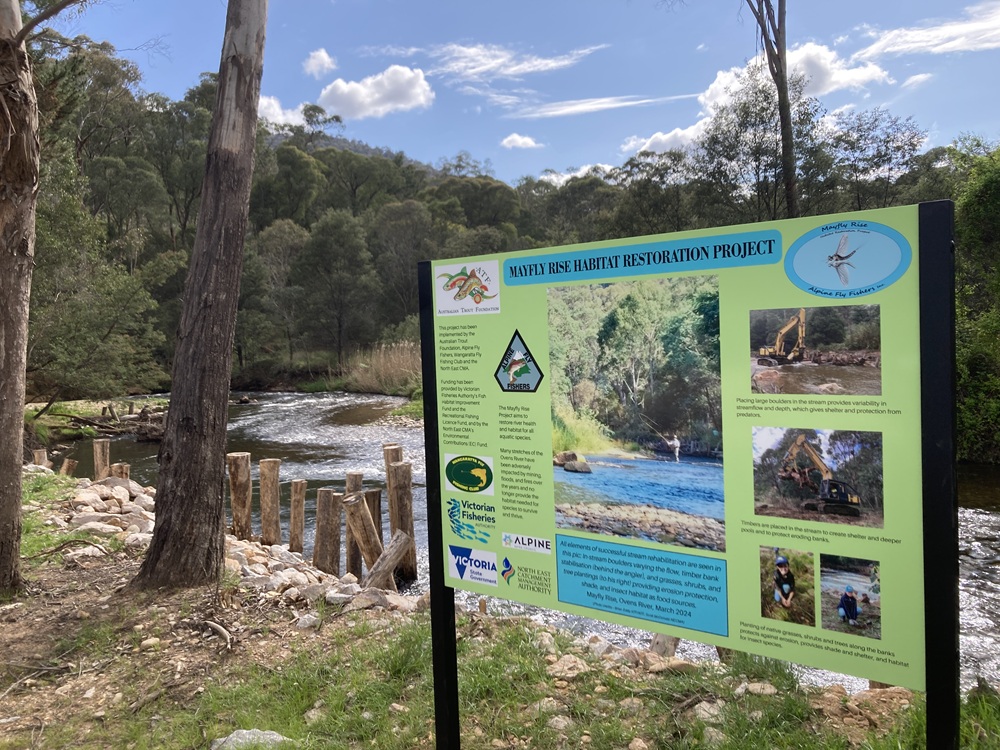
Fishing a section of improved habitat on the Ovens River.
“I will explain to him… if the trout are lost, smash the state… Whether it is the trout or the angler who is more sensitised to the degeneration of habitat would be hard to say, but probably it is the trout. At the first signs of deterioration, this otherwise vigorous fish just politely quits, as if to say, ‘if that’s how you want it…’ Meanwhile, the angler qualitatively lapses in citizenship.”
Thomas McGuane, The Longest Silence
McGuane is writing here in relation to one of his home waters in Montana, which dries out in late summer due to the irrigation offtakes upstream.
It’s a simple lesson, and a simple answer to the timeless question: any luck?
No. No water means no fish.
It also points to the role people who love healthy rivers can play in supporting them – and what can happen when those who don’t care for them in the same way come to misuse them.
Low water is not uncommon when it comes to trout in streams in Victoria, and while many of them are thankfully still flowing despite a very dry start to 2025, it can mean answering the “Any luck?” question is not as easy as it is in wet years. It also makes good instream habitat essential to improving your chances.
Seeking good habitat… and fishing success
Some people will tell you they haven’t caught any trout in the 2024/25 season, but others have been getting onto them. I wanted to see for myself, and so I visited the Ovens and Buckland rivers in late March and early April to fish stretches of water featuring boulders, logjams and other features put there as part of instream habitat works completed in the last 5-10 years.
I’d been fishing habitat works sections of the Ovens near Bright for years before I realised they’d been deliberately enhanced. I always found fish there, so I always returned. It was appealing water.
I’ve since learned the works were completed thanks to coordination and funding from the Australian Trout Foundation (ATF), members of local groups like the Alpine Fly Fishers, Upper Ovens Landcare Group, Wangaratta Fly Fishers, the North-East Catchment Management Authority (NECMA), and the Victorian Fisheries Authority (VFA). This information is highlighted on signs along the stretch, I just never stopped to read them in my race to the water!
If McGuane were to know the people involved in this work, they would be found to be strong citizens, civically engaged for the betterment of riverine health in the modern political and economic climate. These rivers are safe for now.
Given my past success on the Ovens, I was excited to fish more works, completed in 2019, on the Buckland. While there, I saw the telltale logjams and boulders in the stream that help vary the flow of the water. Among other benefits, they’re strategically positioned to scour out sections of the streambed and provide cover and deeper water in which the fish can reside.
Tussocks of green sedge grass, planted as part of the works, were bright against the rocks and the river, providing a home for the caddis and other insect life.
As flyfishers we know what good water looks like: that varied flow and depth, where the faster water, still riffled, flows from the shallows into comparative depth beside snags and boulders, and past the overhanging grasses or bushes. We feel it in our soul in a split second – even if we don’t necessarily explain what we’re seeing in the way the science might: cool, oxygenated water, cover and food = fish.
.jpg)
As flyfishers, we often intuatively know what good water looks like, such as this habitat-improved section of the Buckland River.
This water stands out all the more when the river levels are low and the water clear, as they were everywhere on this trip.
I started fishing with an Elk Hair Caddis, but after half an hour of not seeing a fish, I added a nymph dropper. This created a bit of excitement as the dry started going under, but I wasn’t connecting with anything except occasional rocks and sticks in the low flows.
Then I came to a promising little drop-off by a boulder. The fly went under, and I lifted from thin water into thin air. As cormorants, water temps, low flows and unsolved mysteries of the natural world were blamed for the bad fishing, in this instance the fisher might’ve been better off pointing the finger at himself (although where does self-criticism get anyone?). I cast further into the eye of the drop-off and the fly went down again. I struck, I felt a heavy thunk, and the fly flew clear of the water once more.
As the environment hones the wild things in it, and the habitat improves the environs for fish, so did it become clear I needed to improve.
This thought was drifting in me like the river when I looked away from my Caddis on the next riffle and off into the tall gum trees along the banks. I didn't know I'd looked away until I looked back and couldn’t see my fly.
I lifted, and soon had a just under ‘pan-sized’ rainbow to hand on the nymph, more the result of good fortune than skilful fishing.
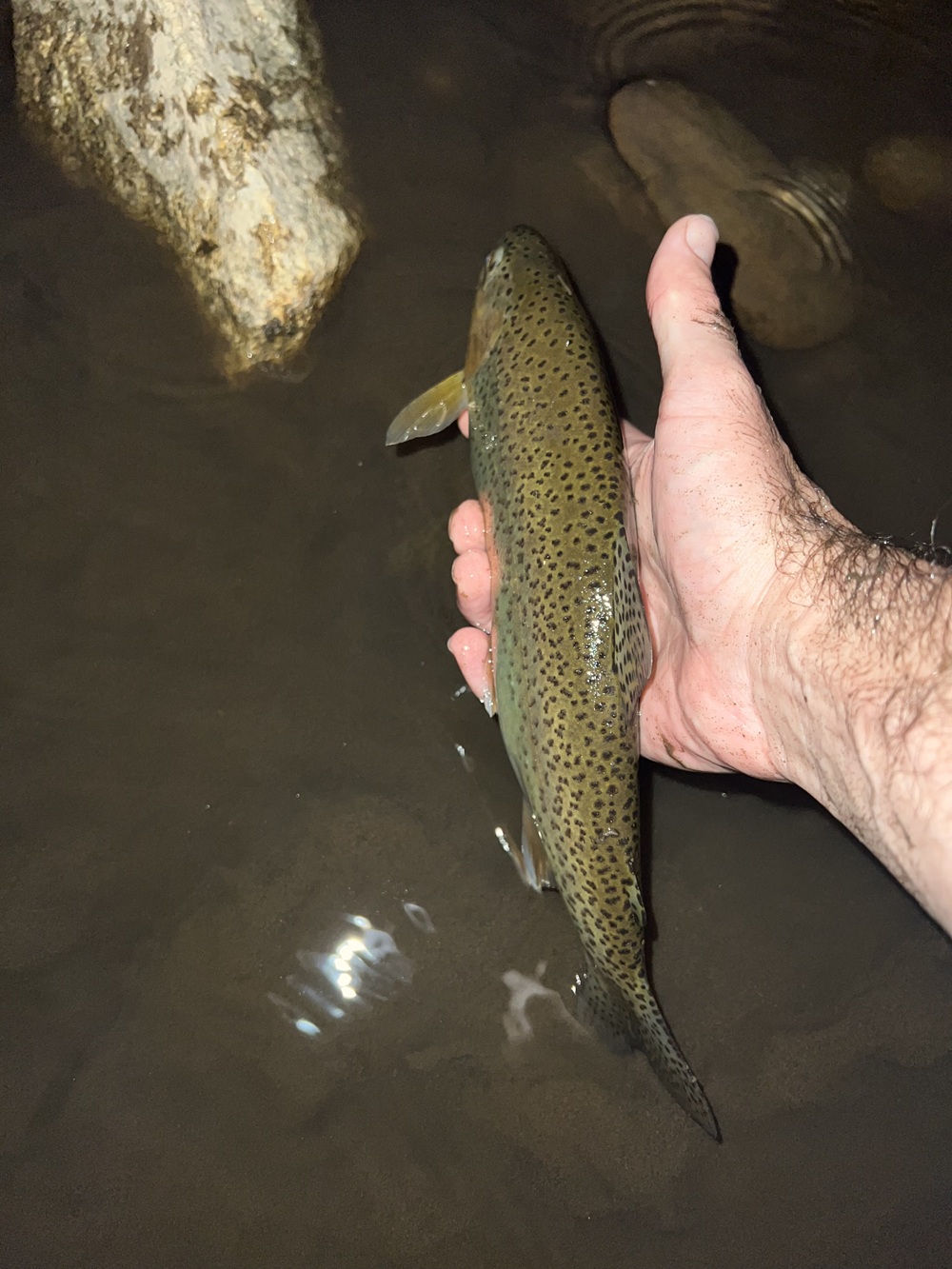
Living proof from the Buckland.
“You got one out of the Buckland?” said a fisher I ran into on the Ovens a few days later. “Well done. The Buckland is shocking.”
Maybe not anymore in the habitat stretch.
The Mayfly Rise project
Not long after catching that rainbow, I headed to the Mayfly Rise section on the Ovens River to fish the evening rise. This reach of habitat work received an award at last year’s Talk Wild Trout conference.
The award acknowledged the work done by those involved to improve the ecology of a river that had been ‘obliterated’, according to one river manager, by the alluvial mining along it from Myrtleford to Harrietville during the gold rush. Its cause was not helped by river management in the middle of last century, which thought it better to take the remaining fallen trees and branches out of a river, rather than leave them in.
With nothing holding the river together or slowing the water’s passage, the river becomes wider and shallower with every flood, reducing the varied habitat and flow required to maintain a healthy river ecology. Its impacts are still seen and felt in sections of the Ovens today, particularly in dry years.
Mayfly Rise, and its sister project Mayfly Rise 2.0, are looking to put that right. Together, they comprise 30 large boulders seeded in the riverbed, five extensive log jams, and numerous timber revetments held in place by blue-gum pins. The works are interspersed along a roughly four-kilometre stretch of river. The projects have also completed four hectares of riparian woody weed control, with hundreds of native plants planted along the banks thanks to the ATF’s Trees for Trout volunteer planting days.
The instream works return natural meanders to the stream, and provide depth, cooler water, and places to reside for the myriad species that need these conditions to survive and thrive. With plantings increasing insect life, the works also benefit the river downstream by preventing erosion that can cause silt to fill deeper fish-holding pools. The logjams trap the silt, making a natural soil structure in which plants can grow, and platypus can make their burrows.
Signage helps to locate and describe the award-winning Mayfly Rise habitat collaboration: an example of what can happen when McGuane's 'good citizens' work together.
NECMA-commissioned research on Mayfly Rise, undertaken by the Arthur Rylah Institute as part of Upper Ovens Flagship Project, has helped establish baseline data on the fish species the work is supporting, with research in September 2023 and March 2024 showing lots of trout, two-spined blackfish and riffle galaxia, as well as a spiny crayfish and a couple of platypus living where works had been completed.
Numbers were greater across all classes in the March sampling, and while the report noted this could be due to lower water levels making their sampling methods more effective, it was still encouraging to see the types and quantities of species found in the stretch.
While my fishing methods may not be as effective as the fyke nets and electrofishing equipment used by the ARI’s researchers, I was keen to see for myself with a fly rod (and the naked eye) if the trout would reveal themselves in 2025, particularly given the reports of challenging fishing around the state compared to other years.
In the last of the light in 100 metres of river in the Mayfly Rise section, I saw up to a dozen rising fish and caught four of them, all rainbows. The last was a very chunky fish of a pound or so that came to hand on the nymph.
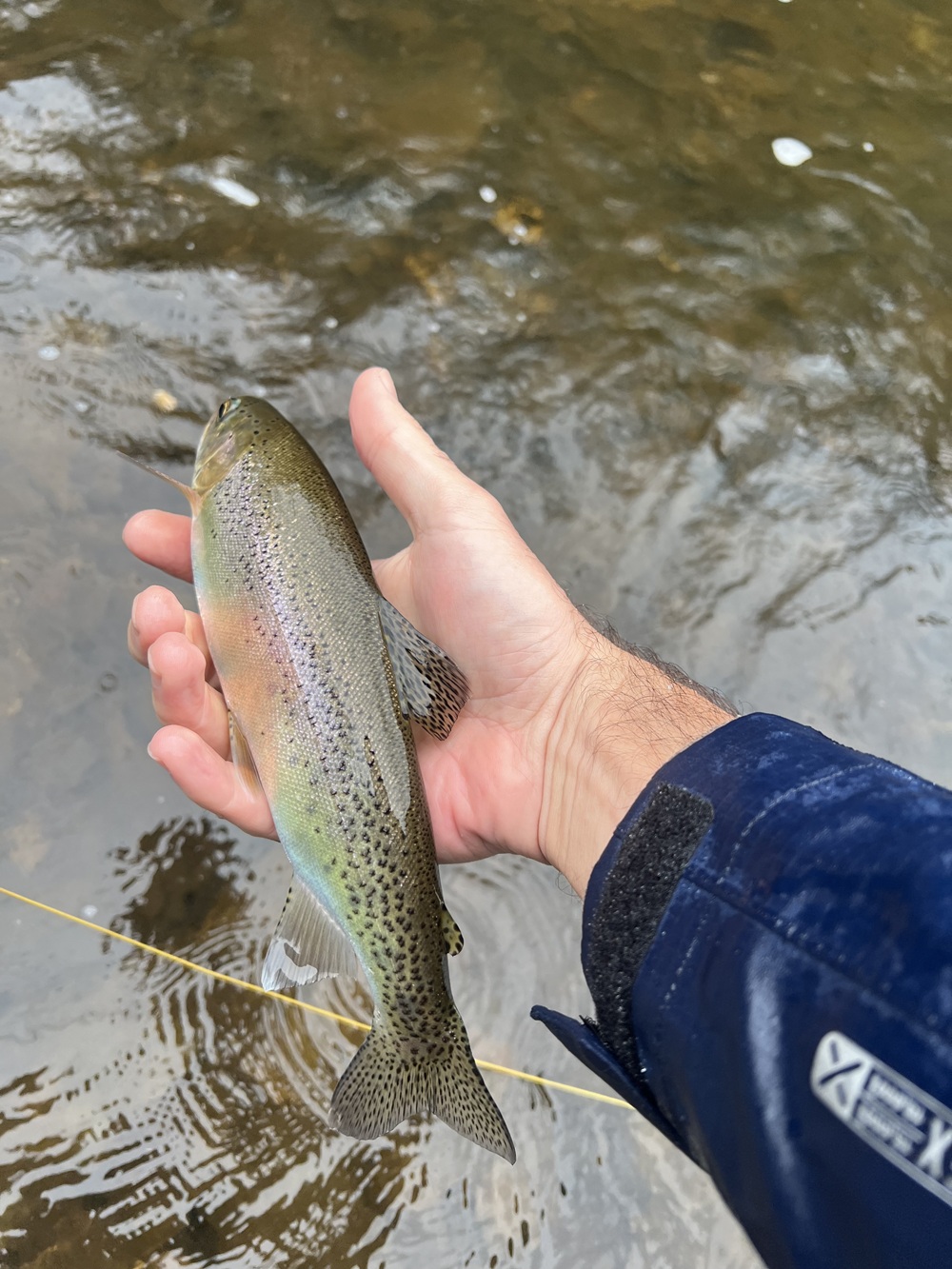
Mayfly Rise resident.
I returned at dawn the next morning and fished a pool beneath a rock wall around the bend upstream. The flash of an even bigger rainbow was more visible than the rising sun as it broke me off on the strike.
Once I’d tied on and tested more tippet and new flies, I moved up into the eye of the run and caught four more small rainbows on the nymph, making it eight or so in a few hours fishing either side of the night with a few more dropped or seen.
The Mayfly Rise 2.0 section not far upstream, where habitat works were more recently completed, also delivered some fish. Again, behind the logjams and boulders, the flowing water had scoured out nice depressions and cover in which the fish could hold and feed.
I busted off again on a rainbow, which had no right to fight that hard, but pulled strongly in the shallow water. In a deeper riffle on the next section up I missed a better fish on the dry.
So many things can go wrong in fishing, in river management, in life.
Fire and flood
In 2013, floods following big fires in the Ovens catchment across Mount Hotham sent a big slug of ashy, muddy water down the river, wiping out many fish and the wider ecology of the waterway near Harrietville.
To help bring life back to the river quickly, another section of habitat work at Frosty Corner was supported through government grants. The 1.5-kilometre stretch is downstream of Howard's Bridge in the mountain town.
I fished here too, and caught or dropped about a dozen fish. As well as some tiddlers with par marks still on their sides (a good sign for next season) a couple of 25-centimetre fish came to hand. A rainbow nearly twice as big again sipped the caddis before exploding back under the undercut from which it had emerged, breaking me off in the process.
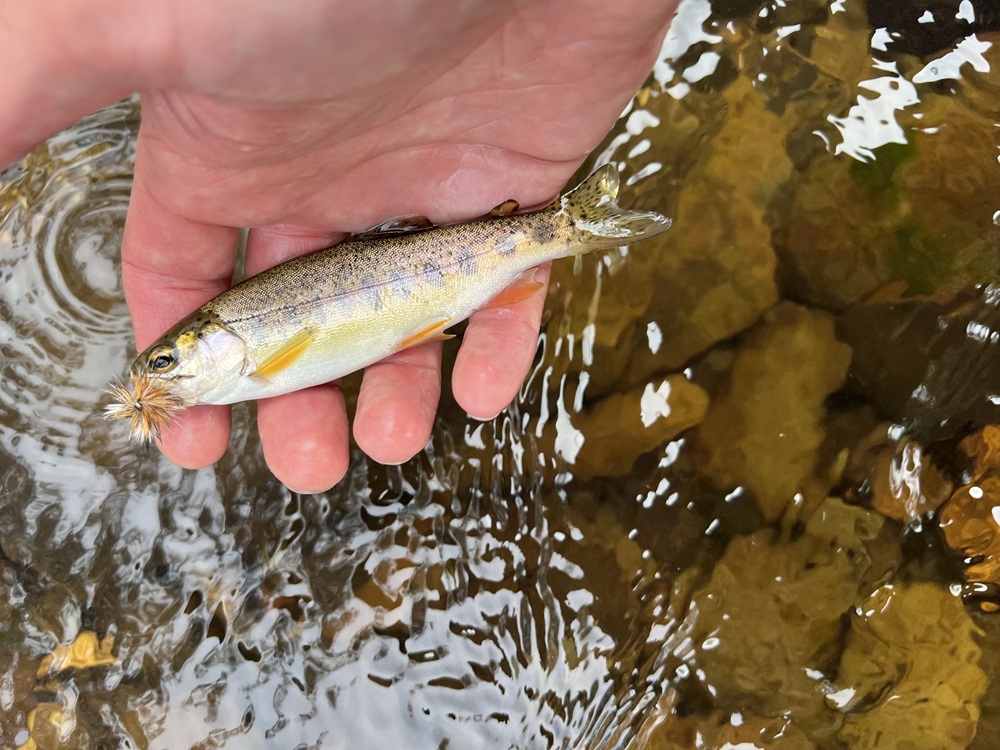
In some ways, the presence of little fish is just as important as finding the big ones: they're proof of successful recruitment, and offer promise for next season.
As a control (I’m nothing if not scientific), I fished a couple of other sections of the river near Smoko that hadn’t had habitat works done.
At Smoko, I was struck again by the lower water level compared to almost the same time last year. There was a small run by a submerged tree branch I had fished then, which yielded four or five fish – but now looked a foot lower than it had been 12 months ago.
Thinking back on my trip now, perhaps the trout, while in good condition, were desperately competing with each other for diminishing food in diminishing flows, so weren’t being spooked easily and more willing to take anything crossing their paths.
As I fished the stretch this year, and didn’t see a fish or even an area they could hold due to the water level, I did get a mid-air take from a big dragonfly that was buzzing around (my line fell across it, or it caught my line and dragged it around for a little bit - it was hard to tell).
This big insect, a predator of other insects, reminded me of the plague of them we had on the coast where I live one summer a few years ago, during one of those very wet years. The air was filled with clouds of them for days on end.
A similar thing happened with ladybugs, also predators of insects, a year later down the Great Ocean Road on a very warm evening in early March. Clouds of them feasted on the thrip that filled the air and crawled on our skin. The moisture in the air and evaporating from the grass was still palpable. The whole great food chain of insect life was booming in the warm, wet conditions.
As the dragonfly in Smoko dropped my line and buzzed off, I couldn’t help feeling the trout we had been fishing for during the three seasons preceding this one, had been similarly abundant, and similarly feasting on a booming food chain. That extra water in the stream, the ecology it sustained, was all the habitat they needed for a while.
Then, with less water, the river held fewer fish. The wild, water-dependent populations of trout and insects had boomed and crashed.
It seems too obvious to even mention that water is the most important habitat. But even with that in decline this year, the river thankfully still held plenty of trout in the sections which had received habitat work. The fish had the cover, cool oxygenated water, and food supply to survive and thrive.
Other locations
It’s not just the Ovens and Buckland rivers that have benefited from habitat works, which often happen thanks to the advocacy and coordination of the ATF and Victoria’s catchment management authorities. Instream habitat and riparian revegetation projects have been completed (among other places) at:
- Nariel & Thowgla Creeks near Corryong
- Mitta Mitta at Tallandoon and Katie Peters Reserve
- Snowy Creek
- Cobungra River
- Livingstone Creek
- Steavenson River
- Rubicon River
- Delatite River
- Howqua River
- Jamieson River
- Macalister River
- Goulburn River
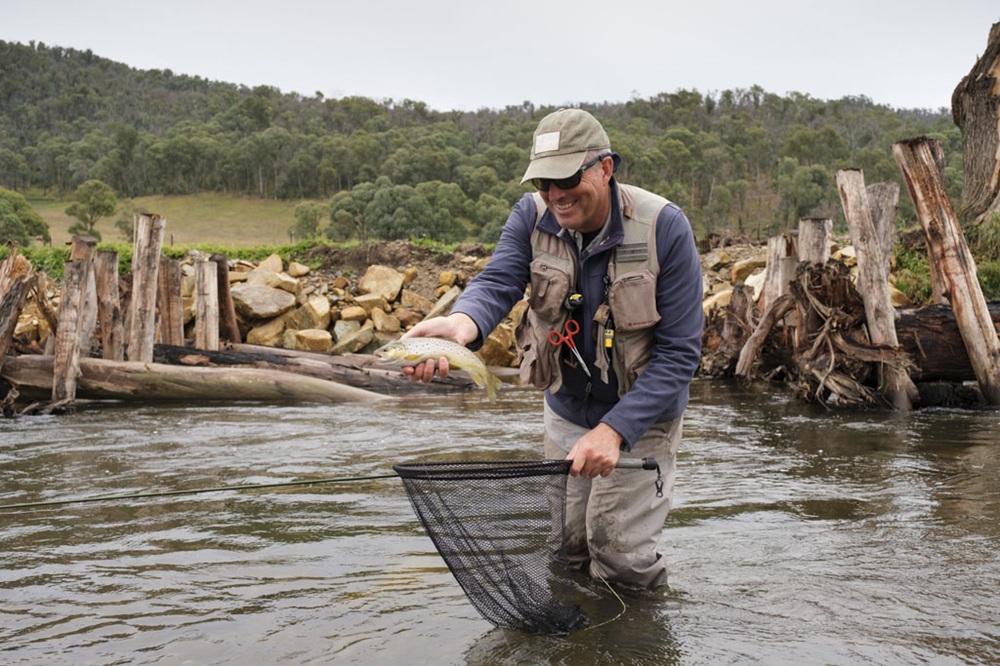
Habitat works on the bushfire-ravaged Nariel Creek were quickly occupied by trout and other species. (David Anderson pic.)
As the funding for the projects generally comes at least in part (and often in total) from the VFA’s Recreational Fishing Grants program (supported by funding from the CMAs and other agencies where possible) works are all in places which offer access to recreational fishers. A Google search of the above places will often show you where they are, with some, like the ones I fished for this article, marked on Google maps.
Footnote
In further exciting news for Ovens River fishers, major instream habitat works in the Ovens at Porepunkah were completed by NECMA just as this article was being finalised. Keep an eye out for another FlyStream article on this project, called ‘Bridging Waters’, in the coming months.
The writer would like to thank ATF’s Paul Stolz and Ray Ferguson, Alpine Fly Fisher’s Brian Eddy, NECMA’s Scott McDonald, ARI’s Jarod Lyon and VFA’s Andrew Briggs for the information shared on the projects featured in this article… and for the quality of the fishing in the habitat-improved stretches on the Ovens River!





